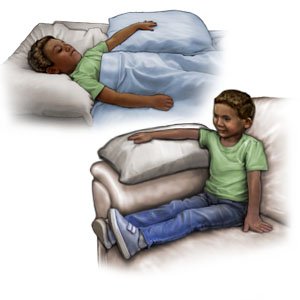Finger Fracture in Children
Medically reviewed by Drugs.com. Last updated on Aug 4, 2025.
What is a finger fracture?
A finger fracture is a break in one or more of the bones in your child's finger.
What are the signs and symptoms of a finger fracture?
- Pain, bruising, or swelling
- Weakness or numbness
- Trouble moving the finger
- Finger shape is not normal
How is a finger fracture diagnosed and treated?
Your child's healthcare provider will examine your child and ask about his or her injury. An x-ray may be used to check for a break or other damage. Treatment may include any of the following:
- A cast or splint helps prevent movement and protects your child's finger so it can heal.
- NSAIDs , such as ibuprofen, help decrease swelling, pain, and fever. This medicine is available with or without a doctor's order. NSAIDs can cause stomach bleeding or kidney problems in certain people. If your child takes blood thinner medicine, always ask if NSAIDs are safe for him or her. Always read the medicine label and follow directions. Do not give these medicines to children younger than 6 months without direction from a healthcare provider.
- Acetaminophen decreases pain and fever. It is available without a doctor's order. Ask how much to give your child and how often to give it. Follow directions. Read the labels of all other medicines your child uses to see if they also contain acetaminophen, or ask your child's doctor or pharmacist. Acetaminophen can cause liver damage if not taken correctly.
- Closed reduction is used to put your child's bone back into the correct position without surgery.
- Open reduction surgery may be needed to put your child's bone back into the correct position. Wires, pins, plates, or screws may be used to keep the broken pieces lined up correctly.
How can I help manage my child's symptoms?
- Have your child wear his or her splint as directed. Do not remove the splint until you follow up with your child's healthcare provider or hand specialist.
- Apply ice on your child's finger for 15 to 20 minutes every hour or as directed. Use an ice pack, or put crushed ice in a plastic bag. Cover it with a towel before you apply it to your child's skin. Ice helps prevent tissue damage and decreases swelling and pain.
- Elevate your child's finger above the level of his or her heart as often as you can. This will help decrease swelling and pain. Prop your child's hand on pillows or blankets to keep it elevated comfortably.

When should I seek immediate care?
- Your child's cast or splint gets wet, damaged, or comes off.
- Your child says his or her splint or cast feels too tight.
- Your child has severe pain in his or her finger.
- Your child's finger is cold, numb, or pale.
When should I call my child's doctor?
- Your child's pain or swelling gets worse, even after treatment.
- You have questions or concerns about your child's condition or care.
Care Agreement
You have the right to help plan your child's care. Learn about your child's health condition and how it may be treated. Discuss treatment options with your child's healthcare providers to decide what care you want for your child. The above information is an educational aid only. It is not intended as medical advice for individual conditions or treatments. Talk to your doctor, nurse or pharmacist before following any medical regimen to see if it is safe and effective for you.© Copyright Merative 2025 Information is for End User's use only and may not be sold, redistributed or otherwise used for commercial purposes.
Learn more about Finger Fracture
Care guides
Further information
Always consult your healthcare provider to ensure the information displayed on this page applies to your personal circumstances.
